Financial Accounting Case Study Report: Technology Enterprises Ltd
VerifiedAdded on 2023/04/22
|11
|2617
|232
Report
AI Summary
This report provides an in-depth analysis of financial accounting practices, with a specific focus on intangible assets and the relevant accounting standards, AASB 138 and IAS 38. The report begins with an executive summary and introduction to financial accounting, emphasizing the importance of accurately recording transactions and adhering to accounting standards. The core of the report involves a detailed examination of AASB 138/IAS 38, including the recognition and measurement of intangible assets. The report then presents a case study of Technology Enterprises Ltd, a company that conducted research and development to modify its battery recharging methods. The report analyzes how Technology Enterprises Ltd should account for the costs associated with the research and development, as well as the valuation of the resulting intangible asset, considering the present value approach and fair value approach. The report also discusses the reduction of comparability in financial statements, and the importance of following accounting standards to ensure consistency and transparency. Finally, the report examines the accounting treatment of research costs and asset development costs, providing a comprehensive overview of the accounting for intangible assets.
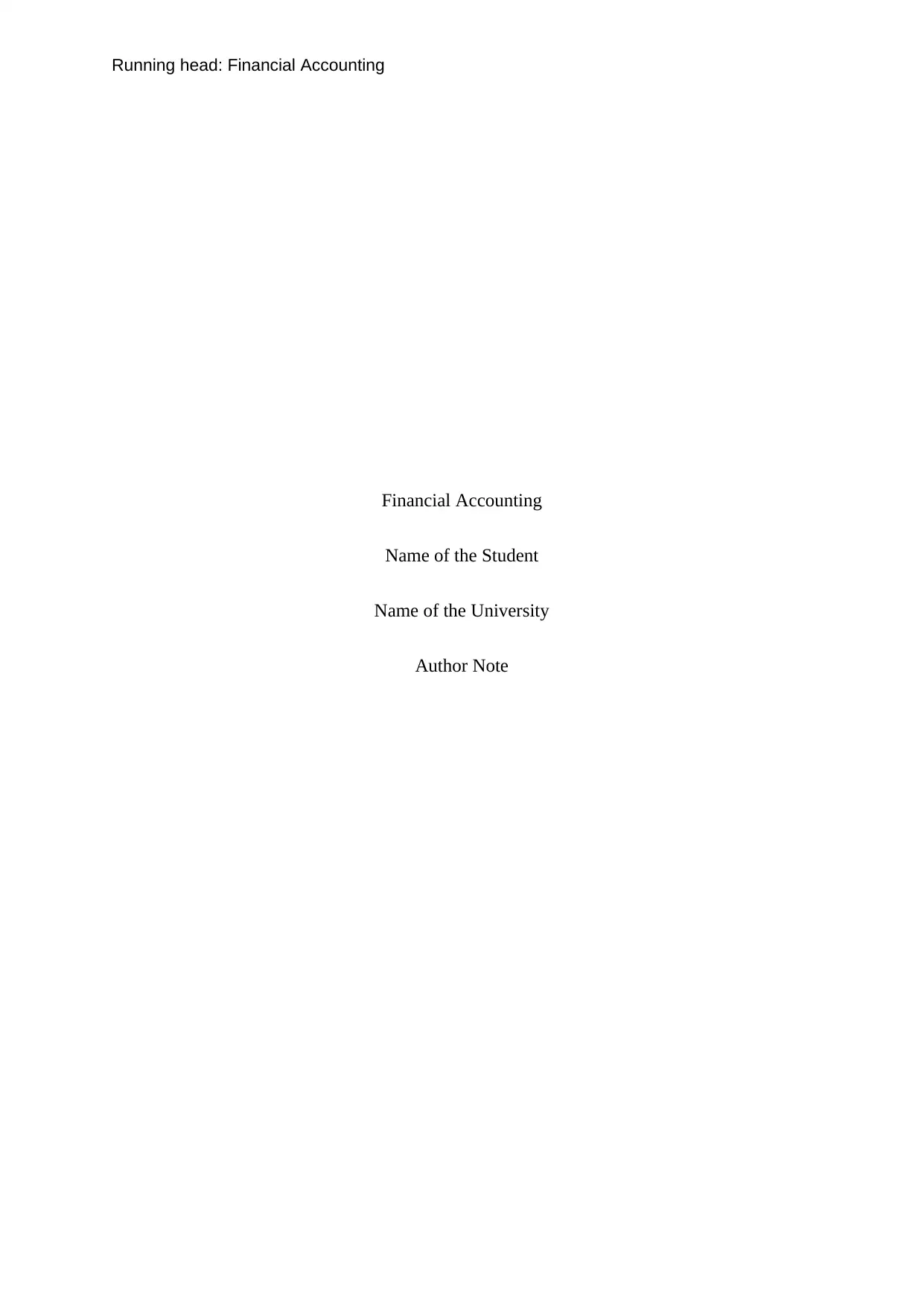
Running head: Financial Accounting
Financial Accounting
Name of the Student
Name of the University
Author Note
Financial Accounting
Name of the Student
Name of the University
Author Note
Paraphrase This Document
Need a fresh take? Get an instant paraphrase of this document with our AI Paraphraser
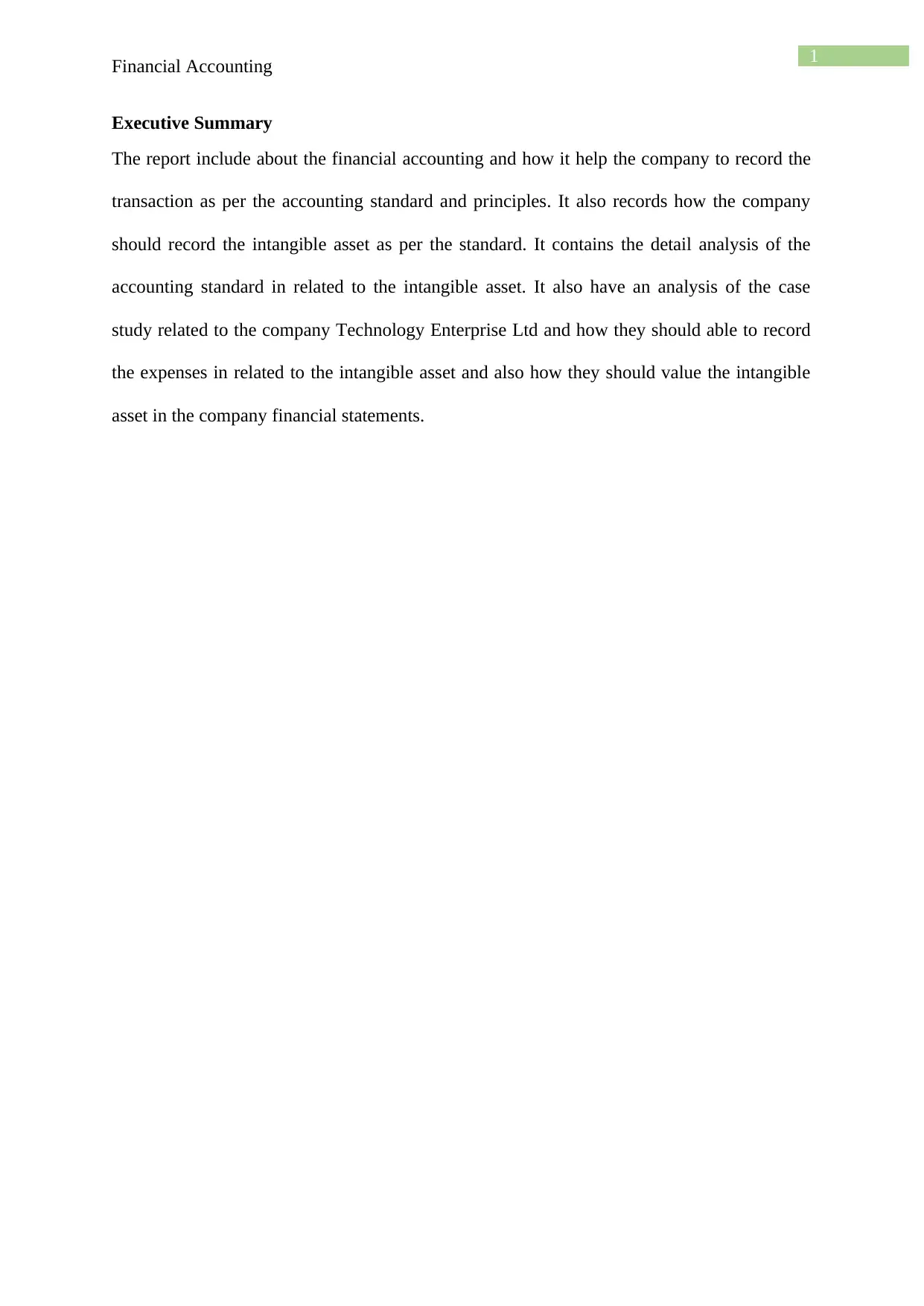
1
Financial Accounting
Executive Summary
The report include about the financial accounting and how it help the company to record the
transaction as per the accounting standard and principles. It also records how the company
should record the intangible asset as per the standard. It contains the detail analysis of the
accounting standard in related to the intangible asset. It also have an analysis of the case
study related to the company Technology Enterprise Ltd and how they should able to record
the expenses in related to the intangible asset and also how they should value the intangible
asset in the company financial statements.
Financial Accounting
Executive Summary
The report include about the financial accounting and how it help the company to record the
transaction as per the accounting standard and principles. It also records how the company
should record the intangible asset as per the standard. It contains the detail analysis of the
accounting standard in related to the intangible asset. It also have an analysis of the case
study related to the company Technology Enterprise Ltd and how they should able to record
the expenses in related to the intangible asset and also how they should value the intangible
asset in the company financial statements.
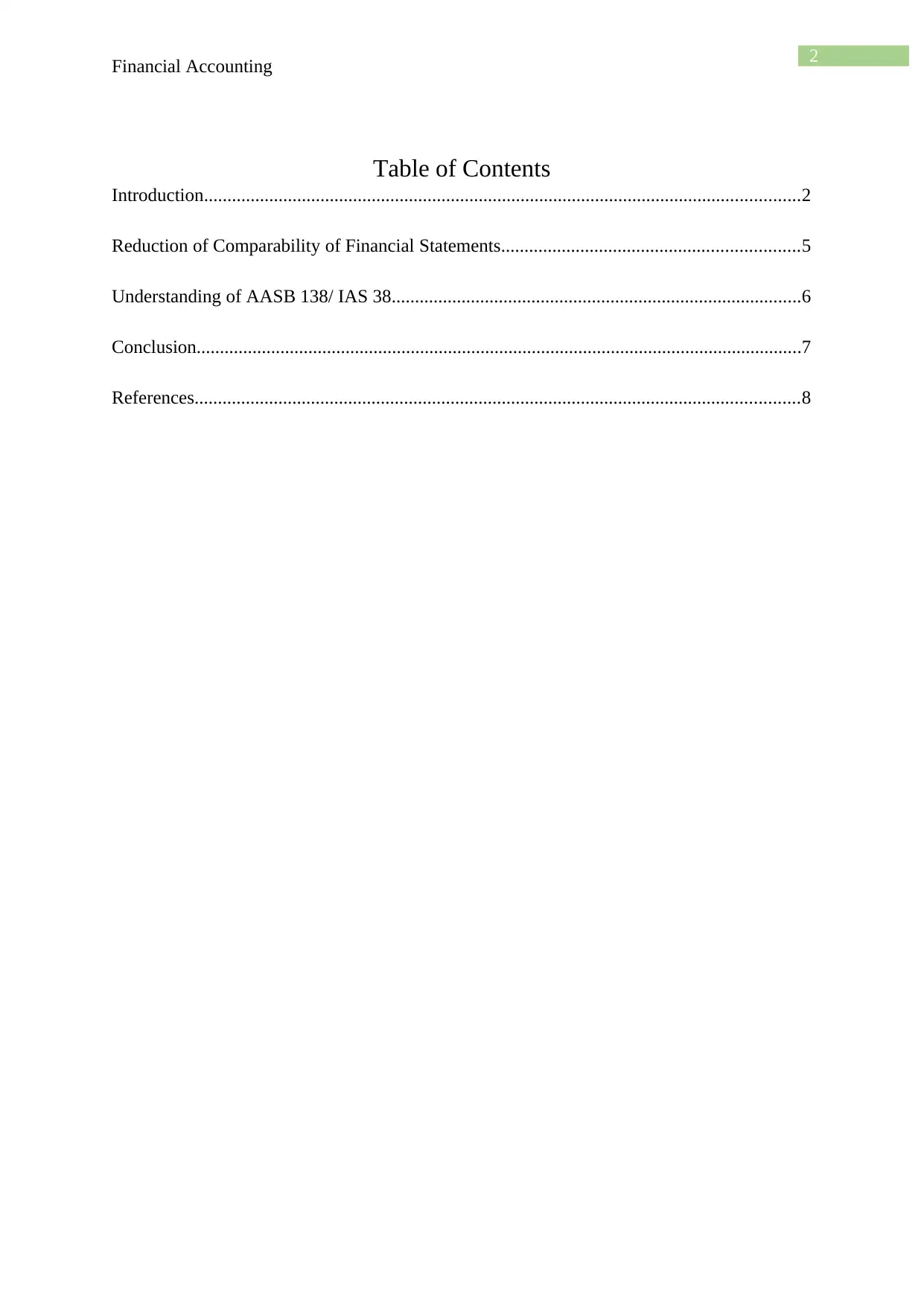
2
Financial Accounting
Table of Contents
Introduction................................................................................................................................2
Reduction of Comparability of Financial Statements................................................................5
Understanding of AASB 138/ IAS 38........................................................................................6
Conclusion..................................................................................................................................7
References..................................................................................................................................8
Financial Accounting
Table of Contents
Introduction................................................................................................................................2
Reduction of Comparability of Financial Statements................................................................5
Understanding of AASB 138/ IAS 38........................................................................................6
Conclusion..................................................................................................................................7
References..................................................................................................................................8
⊘ This is a preview!⊘
Do you want full access?
Subscribe today to unlock all pages.

Trusted by 1+ million students worldwide
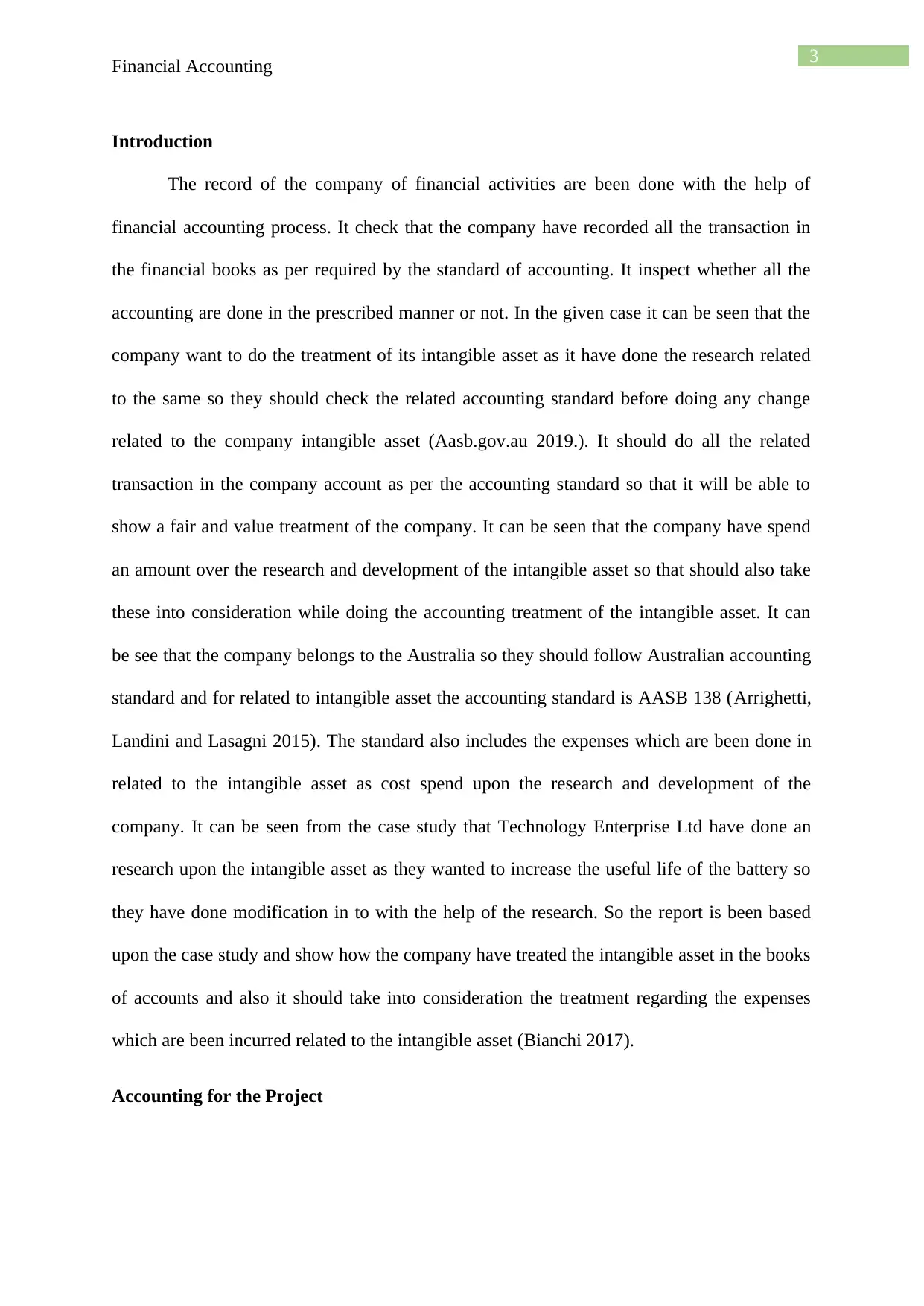
3
Financial Accounting
Introduction
The record of the company of financial activities are been done with the help of
financial accounting process. It check that the company have recorded all the transaction in
the financial books as per required by the standard of accounting. It inspect whether all the
accounting are done in the prescribed manner or not. In the given case it can be seen that the
company want to do the treatment of its intangible asset as it have done the research related
to the same so they should check the related accounting standard before doing any change
related to the company intangible asset (Aasb.gov.au 2019.). It should do all the related
transaction in the company account as per the accounting standard so that it will be able to
show a fair and value treatment of the company. It can be seen that the company have spend
an amount over the research and development of the intangible asset so that should also take
these into consideration while doing the accounting treatment of the intangible asset. It can
be see that the company belongs to the Australia so they should follow Australian accounting
standard and for related to intangible asset the accounting standard is AASB 138 (Arrighetti,
Landini and Lasagni 2015). The standard also includes the expenses which are been done in
related to the intangible asset as cost spend upon the research and development of the
company. It can be seen from the case study that Technology Enterprise Ltd have done an
research upon the intangible asset as they wanted to increase the useful life of the battery so
they have done modification in to with the help of the research. So the report is been based
upon the case study and show how the company have treated the intangible asset in the books
of accounts and also it should take into consideration the treatment regarding the expenses
which are been incurred related to the intangible asset (Bianchi 2017).
Accounting for the Project
Financial Accounting
Introduction
The record of the company of financial activities are been done with the help of
financial accounting process. It check that the company have recorded all the transaction in
the financial books as per required by the standard of accounting. It inspect whether all the
accounting are done in the prescribed manner or not. In the given case it can be seen that the
company want to do the treatment of its intangible asset as it have done the research related
to the same so they should check the related accounting standard before doing any change
related to the company intangible asset (Aasb.gov.au 2019.). It should do all the related
transaction in the company account as per the accounting standard so that it will be able to
show a fair and value treatment of the company. It can be seen that the company have spend
an amount over the research and development of the intangible asset so that should also take
these into consideration while doing the accounting treatment of the intangible asset. It can
be see that the company belongs to the Australia so they should follow Australian accounting
standard and for related to intangible asset the accounting standard is AASB 138 (Arrighetti,
Landini and Lasagni 2015). The standard also includes the expenses which are been done in
related to the intangible asset as cost spend upon the research and development of the
company. It can be seen from the case study that Technology Enterprise Ltd have done an
research upon the intangible asset as they wanted to increase the useful life of the battery so
they have done modification in to with the help of the research. So the report is been based
upon the case study and show how the company have treated the intangible asset in the books
of accounts and also it should take into consideration the treatment regarding the expenses
which are been incurred related to the intangible asset (Bianchi 2017).
Accounting for the Project
Paraphrase This Document
Need a fresh take? Get an instant paraphrase of this document with our AI Paraphraser
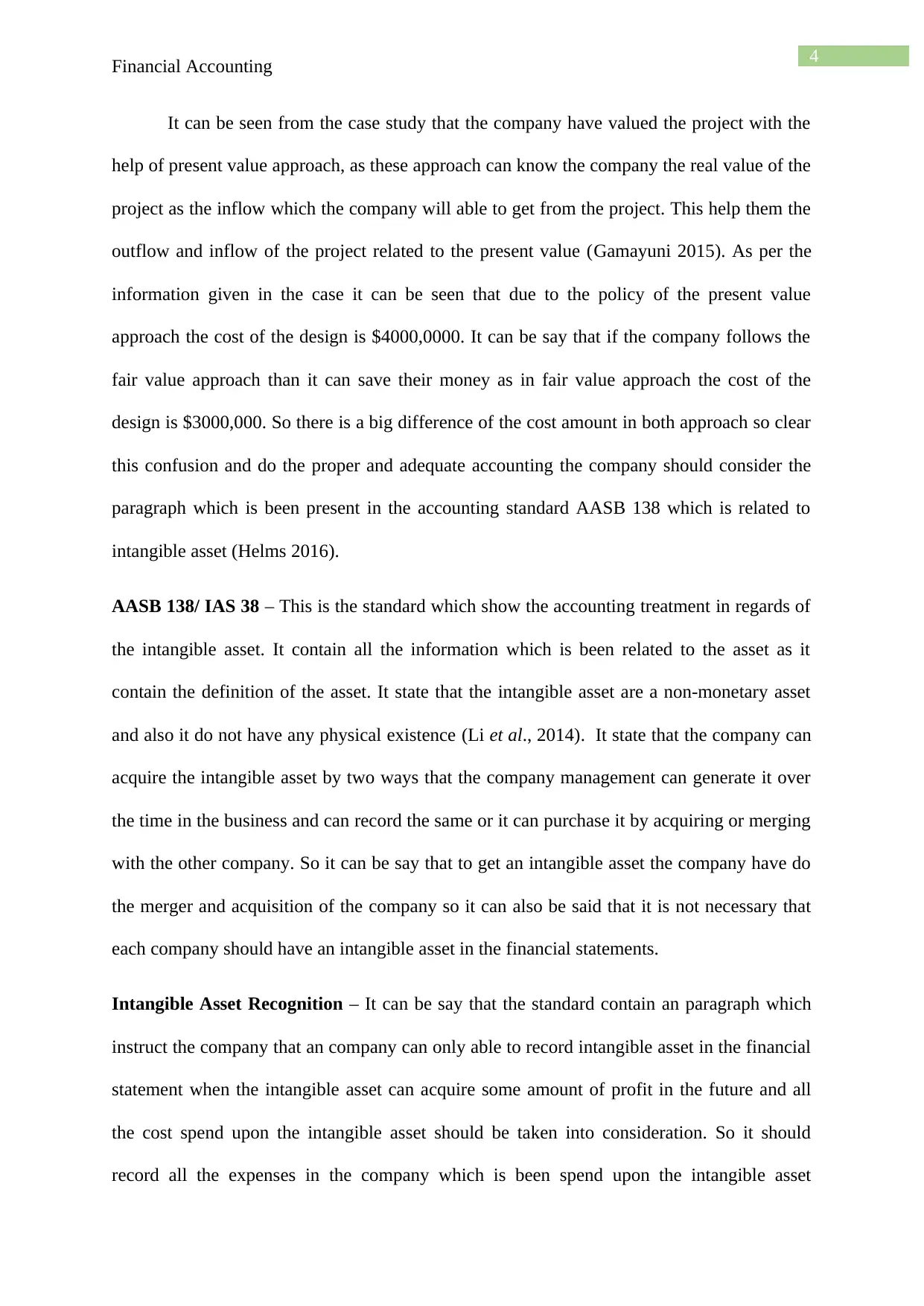
4
Financial Accounting
It can be seen from the case study that the company have valued the project with the
help of present value approach, as these approach can know the company the real value of the
project as the inflow which the company will able to get from the project. This help them the
outflow and inflow of the project related to the present value (Gamayuni 2015). As per the
information given in the case it can be seen that due to the policy of the present value
approach the cost of the design is $4000,0000. It can be say that if the company follows the
fair value approach than it can save their money as in fair value approach the cost of the
design is $3000,000. So there is a big difference of the cost amount in both approach so clear
this confusion and do the proper and adequate accounting the company should consider the
paragraph which is been present in the accounting standard AASB 138 which is related to
intangible asset (Helms 2016).
AASB 138/ IAS 38 – This is the standard which show the accounting treatment in regards of
the intangible asset. It contain all the information which is been related to the asset as it
contain the definition of the asset. It state that the intangible asset are a non-monetary asset
and also it do not have any physical existence (Li et al., 2014). It state that the company can
acquire the intangible asset by two ways that the company management can generate it over
the time in the business and can record the same or it can purchase it by acquiring or merging
with the other company. So it can be say that to get an intangible asset the company have do
the merger and acquisition of the company so it can also be said that it is not necessary that
each company should have an intangible asset in the financial statements.
Intangible Asset Recognition – It can be say that the standard contain an paragraph which
instruct the company that an company can only able to record intangible asset in the financial
statement when the intangible asset can acquire some amount of profit in the future and all
the cost spend upon the intangible asset should be taken into consideration. So it should
record all the expenses in the company which is been spend upon the intangible asset
Financial Accounting
It can be seen from the case study that the company have valued the project with the
help of present value approach, as these approach can know the company the real value of the
project as the inflow which the company will able to get from the project. This help them the
outflow and inflow of the project related to the present value (Gamayuni 2015). As per the
information given in the case it can be seen that due to the policy of the present value
approach the cost of the design is $4000,0000. It can be say that if the company follows the
fair value approach than it can save their money as in fair value approach the cost of the
design is $3000,000. So there is a big difference of the cost amount in both approach so clear
this confusion and do the proper and adequate accounting the company should consider the
paragraph which is been present in the accounting standard AASB 138 which is related to
intangible asset (Helms 2016).
AASB 138/ IAS 38 – This is the standard which show the accounting treatment in regards of
the intangible asset. It contain all the information which is been related to the asset as it
contain the definition of the asset. It state that the intangible asset are a non-monetary asset
and also it do not have any physical existence (Li et al., 2014). It state that the company can
acquire the intangible asset by two ways that the company management can generate it over
the time in the business and can record the same or it can purchase it by acquiring or merging
with the other company. So it can be say that to get an intangible asset the company have do
the merger and acquisition of the company so it can also be said that it is not necessary that
each company should have an intangible asset in the financial statements.
Intangible Asset Recognition – It can be say that the standard contain an paragraph which
instruct the company that an company can only able to record intangible asset in the financial
statement when the intangible asset can acquire some amount of profit in the future and all
the cost spend upon the intangible asset should be taken into consideration. So it should
record all the expenses in the company which is been spend upon the intangible asset
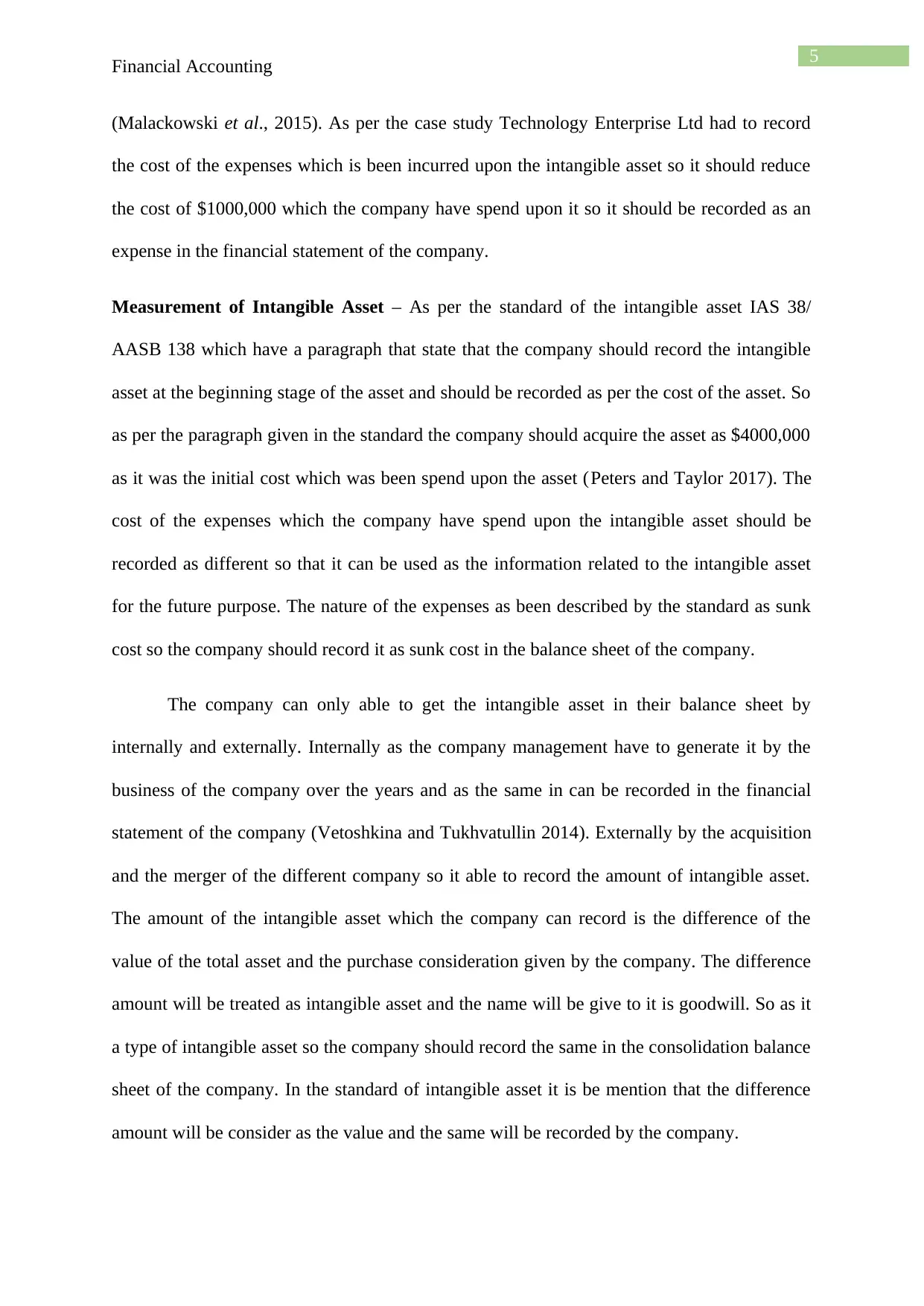
5
Financial Accounting
(Malackowski et al., 2015). As per the case study Technology Enterprise Ltd had to record
the cost of the expenses which is been incurred upon the intangible asset so it should reduce
the cost of $1000,000 which the company have spend upon it so it should be recorded as an
expense in the financial statement of the company.
Measurement of Intangible Asset – As per the standard of the intangible asset IAS 38/
AASB 138 which have a paragraph that state that the company should record the intangible
asset at the beginning stage of the asset and should be recorded as per the cost of the asset. So
as per the paragraph given in the standard the company should acquire the asset as $4000,000
as it was the initial cost which was been spend upon the asset (Peters and Taylor 2017). The
cost of the expenses which the company have spend upon the intangible asset should be
recorded as different so that it can be used as the information related to the intangible asset
for the future purpose. The nature of the expenses as been described by the standard as sunk
cost so the company should record it as sunk cost in the balance sheet of the company.
The company can only able to get the intangible asset in their balance sheet by
internally and externally. Internally as the company management have to generate it by the
business of the company over the years and as the same in can be recorded in the financial
statement of the company (Vetoshkina and Tukhvatullin 2014). Externally by the acquisition
and the merger of the different company so it able to record the amount of intangible asset.
The amount of the intangible asset which the company can record is the difference of the
value of the total asset and the purchase consideration given by the company. The difference
amount will be treated as intangible asset and the name will be give to it is goodwill. So as it
a type of intangible asset so the company should record the same in the consolidation balance
sheet of the company. In the standard of intangible asset it is be mention that the difference
amount will be consider as the value and the same will be recorded by the company.
Financial Accounting
(Malackowski et al., 2015). As per the case study Technology Enterprise Ltd had to record
the cost of the expenses which is been incurred upon the intangible asset so it should reduce
the cost of $1000,000 which the company have spend upon it so it should be recorded as an
expense in the financial statement of the company.
Measurement of Intangible Asset – As per the standard of the intangible asset IAS 38/
AASB 138 which have a paragraph that state that the company should record the intangible
asset at the beginning stage of the asset and should be recorded as per the cost of the asset. So
as per the paragraph given in the standard the company should acquire the asset as $4000,000
as it was the initial cost which was been spend upon the asset (Peters and Taylor 2017). The
cost of the expenses which the company have spend upon the intangible asset should be
recorded as different so that it can be used as the information related to the intangible asset
for the future purpose. The nature of the expenses as been described by the standard as sunk
cost so the company should record it as sunk cost in the balance sheet of the company.
The company can only able to get the intangible asset in their balance sheet by
internally and externally. Internally as the company management have to generate it by the
business of the company over the years and as the same in can be recorded in the financial
statement of the company (Vetoshkina and Tukhvatullin 2014). Externally by the acquisition
and the merger of the different company so it able to record the amount of intangible asset.
The amount of the intangible asset which the company can record is the difference of the
value of the total asset and the purchase consideration given by the company. The difference
amount will be treated as intangible asset and the name will be give to it is goodwill. So as it
a type of intangible asset so the company should record the same in the consolidation balance
sheet of the company. In the standard of intangible asset it is be mention that the difference
amount will be consider as the value and the same will be recorded by the company.
⊘ This is a preview!⊘
Do you want full access?
Subscribe today to unlock all pages.

Trusted by 1+ million students worldwide
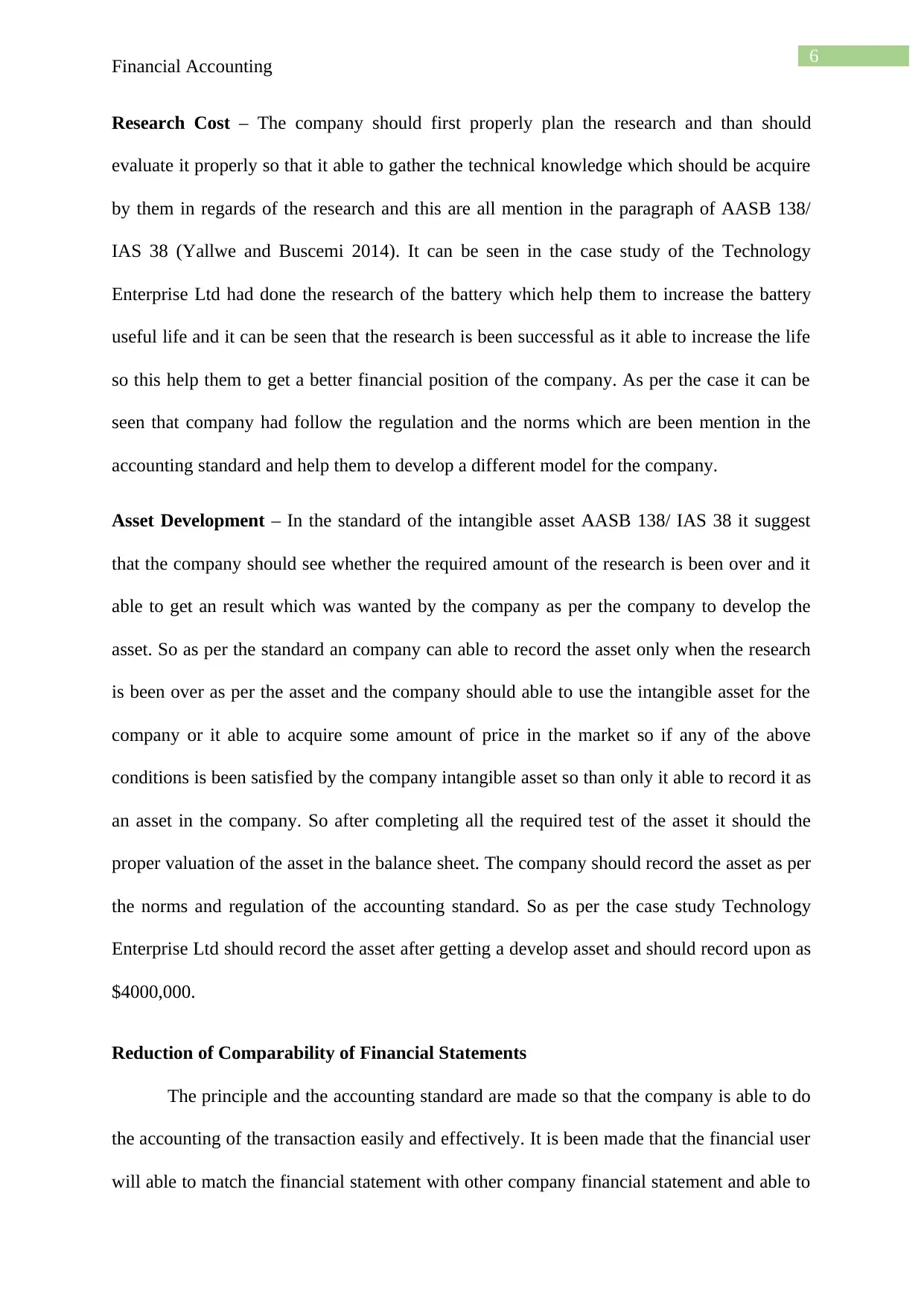
6
Financial Accounting
Research Cost – The company should first properly plan the research and than should
evaluate it properly so that it able to gather the technical knowledge which should be acquire
by them in regards of the research and this are all mention in the paragraph of AASB 138/
IAS 38 (Yallwe and Buscemi 2014). It can be seen in the case study of the Technology
Enterprise Ltd had done the research of the battery which help them to increase the battery
useful life and it can be seen that the research is been successful as it able to increase the life
so this help them to get a better financial position of the company. As per the case it can be
seen that company had follow the regulation and the norms which are been mention in the
accounting standard and help them to develop a different model for the company.
Asset Development – In the standard of the intangible asset AASB 138/ IAS 38 it suggest
that the company should see whether the required amount of the research is been over and it
able to get an result which was wanted by the company as per the company to develop the
asset. So as per the standard an company can able to record the asset only when the research
is been over as per the asset and the company should able to use the intangible asset for the
company or it able to acquire some amount of price in the market so if any of the above
conditions is been satisfied by the company intangible asset so than only it able to record it as
an asset in the company. So after completing all the required test of the asset it should the
proper valuation of the asset in the balance sheet. The company should record the asset as per
the norms and regulation of the accounting standard. So as per the case study Technology
Enterprise Ltd should record the asset after getting a develop asset and should record upon as
$4000,000.
Reduction of Comparability of Financial Statements
The principle and the accounting standard are made so that the company is able to do
the accounting of the transaction easily and effectively. It is been made that the financial user
will able to match the financial statement with other company financial statement and able to
Financial Accounting
Research Cost – The company should first properly plan the research and than should
evaluate it properly so that it able to gather the technical knowledge which should be acquire
by them in regards of the research and this are all mention in the paragraph of AASB 138/
IAS 38 (Yallwe and Buscemi 2014). It can be seen in the case study of the Technology
Enterprise Ltd had done the research of the battery which help them to increase the battery
useful life and it can be seen that the research is been successful as it able to increase the life
so this help them to get a better financial position of the company. As per the case it can be
seen that company had follow the regulation and the norms which are been mention in the
accounting standard and help them to develop a different model for the company.
Asset Development – In the standard of the intangible asset AASB 138/ IAS 38 it suggest
that the company should see whether the required amount of the research is been over and it
able to get an result which was wanted by the company as per the company to develop the
asset. So as per the standard an company can able to record the asset only when the research
is been over as per the asset and the company should able to use the intangible asset for the
company or it able to acquire some amount of price in the market so if any of the above
conditions is been satisfied by the company intangible asset so than only it able to record it as
an asset in the company. So after completing all the required test of the asset it should the
proper valuation of the asset in the balance sheet. The company should record the asset as per
the norms and regulation of the accounting standard. So as per the case study Technology
Enterprise Ltd should record the asset after getting a develop asset and should record upon as
$4000,000.
Reduction of Comparability of Financial Statements
The principle and the accounting standard are made so that the company is able to do
the accounting of the transaction easily and effectively. It is been made that the financial user
will able to match the financial statement with other company financial statement and able to
Paraphrase This Document
Need a fresh take? Get an instant paraphrase of this document with our AI Paraphraser
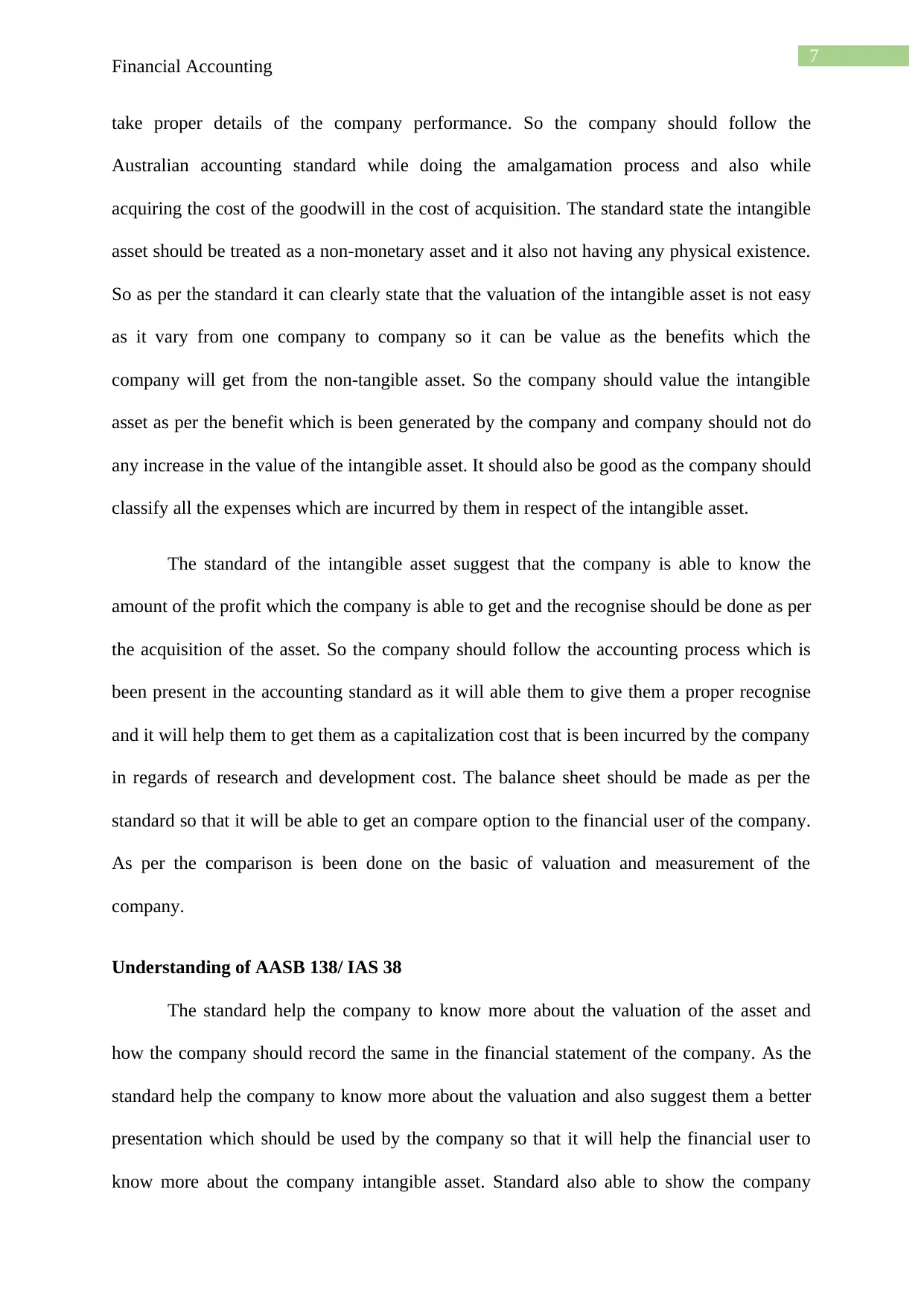
7
Financial Accounting
take proper details of the company performance. So the company should follow the
Australian accounting standard while doing the amalgamation process and also while
acquiring the cost of the goodwill in the cost of acquisition. The standard state the intangible
asset should be treated as a non-monetary asset and it also not having any physical existence.
So as per the standard it can clearly state that the valuation of the intangible asset is not easy
as it vary from one company to company so it can be value as the benefits which the
company will get from the non-tangible asset. So the company should value the intangible
asset as per the benefit which is been generated by the company and company should not do
any increase in the value of the intangible asset. It should also be good as the company should
classify all the expenses which are incurred by them in respect of the intangible asset.
The standard of the intangible asset suggest that the company is able to know the
amount of the profit which the company is able to get and the recognise should be done as per
the acquisition of the asset. So the company should follow the accounting process which is
been present in the accounting standard as it will able them to give them a proper recognise
and it will help them to get them as a capitalization cost that is been incurred by the company
in regards of research and development cost. The balance sheet should be made as per the
standard so that it will be able to get an compare option to the financial user of the company.
As per the comparison is been done on the basic of valuation and measurement of the
company.
Understanding of AASB 138/ IAS 38
The standard help the company to know more about the valuation of the asset and
how the company should record the same in the financial statement of the company. As the
standard help the company to know more about the valuation and also suggest them a better
presentation which should be used by the company so that it will help the financial user to
know more about the company intangible asset. Standard also able to show the company
Financial Accounting
take proper details of the company performance. So the company should follow the
Australian accounting standard while doing the amalgamation process and also while
acquiring the cost of the goodwill in the cost of acquisition. The standard state the intangible
asset should be treated as a non-monetary asset and it also not having any physical existence.
So as per the standard it can clearly state that the valuation of the intangible asset is not easy
as it vary from one company to company so it can be value as the benefits which the
company will get from the non-tangible asset. So the company should value the intangible
asset as per the benefit which is been generated by the company and company should not do
any increase in the value of the intangible asset. It should also be good as the company should
classify all the expenses which are incurred by them in respect of the intangible asset.
The standard of the intangible asset suggest that the company is able to know the
amount of the profit which the company is able to get and the recognise should be done as per
the acquisition of the asset. So the company should follow the accounting process which is
been present in the accounting standard as it will able them to give them a proper recognise
and it will help them to get them as a capitalization cost that is been incurred by the company
in regards of research and development cost. The balance sheet should be made as per the
standard so that it will be able to get an compare option to the financial user of the company.
As per the comparison is been done on the basic of valuation and measurement of the
company.
Understanding of AASB 138/ IAS 38
The standard help the company to know more about the valuation of the asset and
how the company should record the same in the financial statement of the company. As the
standard help the company to know more about the valuation and also suggest them a better
presentation which should be used by the company so that it will help the financial user to
know more about the company intangible asset. Standard also able to show the company
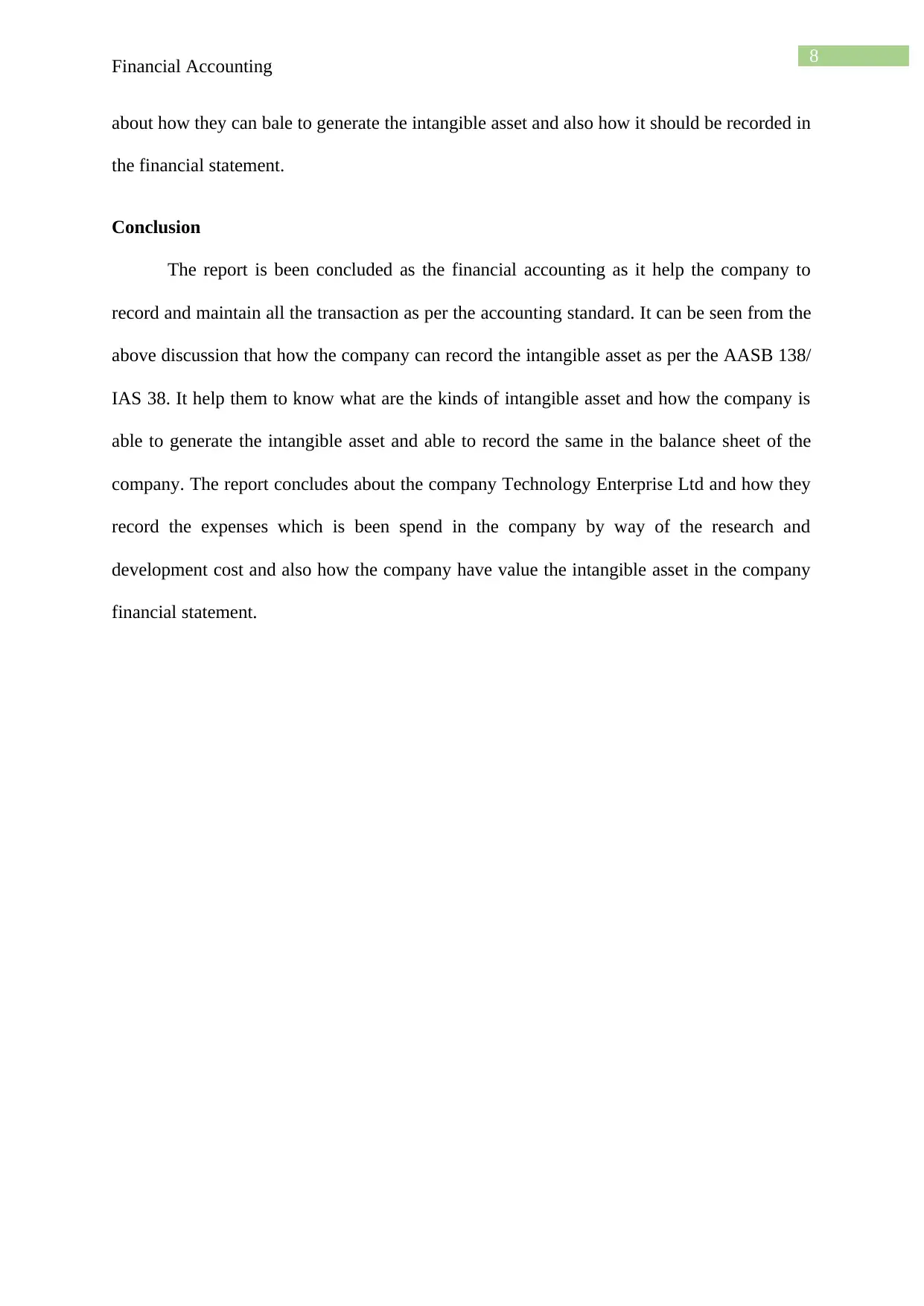
8
Financial Accounting
about how they can bale to generate the intangible asset and also how it should be recorded in
the financial statement.
Conclusion
The report is been concluded as the financial accounting as it help the company to
record and maintain all the transaction as per the accounting standard. It can be seen from the
above discussion that how the company can record the intangible asset as per the AASB 138/
IAS 38. It help them to know what are the kinds of intangible asset and how the company is
able to generate the intangible asset and able to record the same in the balance sheet of the
company. The report concludes about the company Technology Enterprise Ltd and how they
record the expenses which is been spend in the company by way of the research and
development cost and also how the company have value the intangible asset in the company
financial statement.
Financial Accounting
about how they can bale to generate the intangible asset and also how it should be recorded in
the financial statement.
Conclusion
The report is been concluded as the financial accounting as it help the company to
record and maintain all the transaction as per the accounting standard. It can be seen from the
above discussion that how the company can record the intangible asset as per the AASB 138/
IAS 38. It help them to know what are the kinds of intangible asset and how the company is
able to generate the intangible asset and able to record the same in the balance sheet of the
company. The report concludes about the company Technology Enterprise Ltd and how they
record the expenses which is been spend in the company by way of the research and
development cost and also how the company have value the intangible asset in the company
financial statement.
⊘ This is a preview!⊘
Do you want full access?
Subscribe today to unlock all pages.

Trusted by 1+ million students worldwide
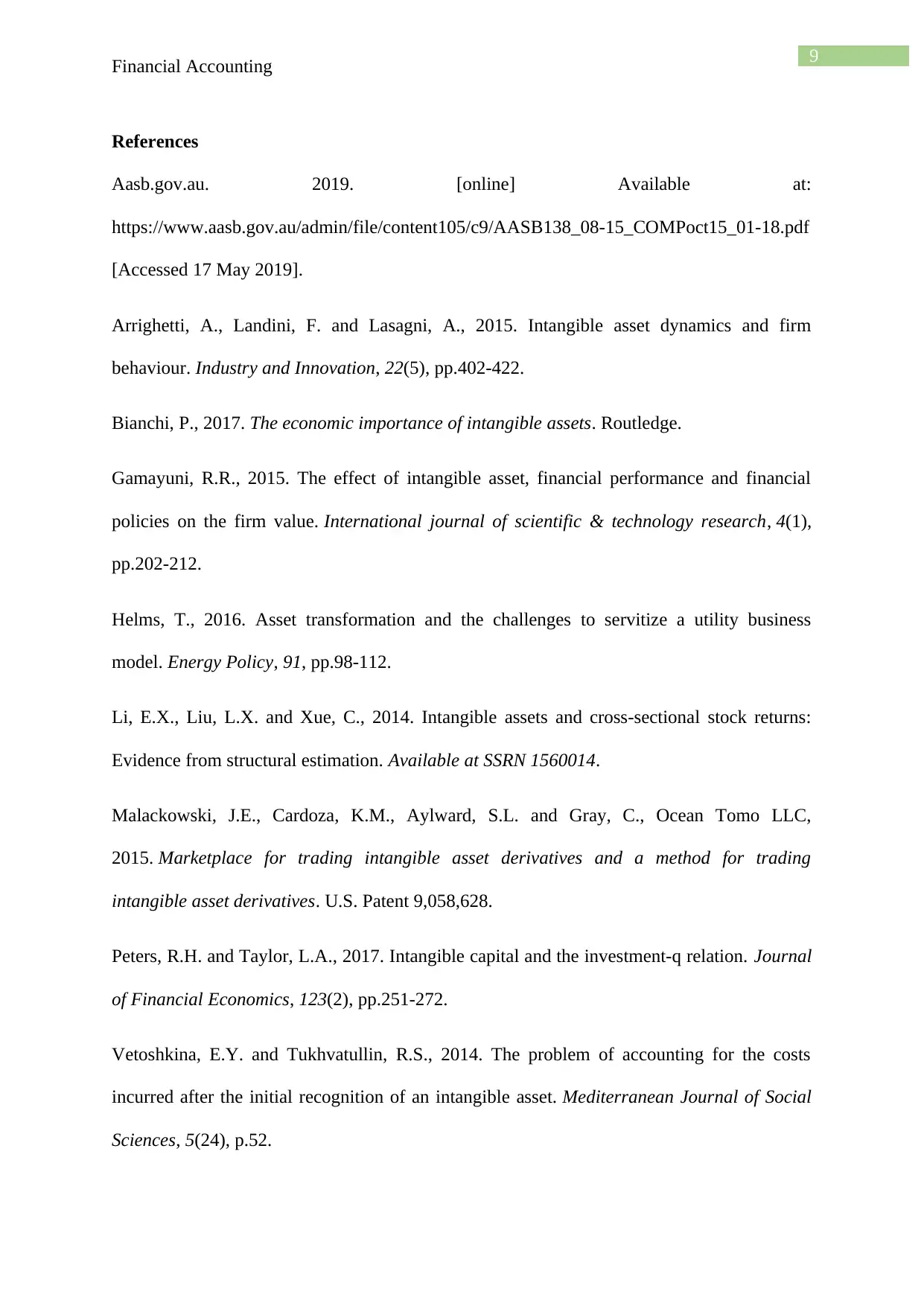
9
Financial Accounting
References
Aasb.gov.au. 2019. [online] Available at:
https://www.aasb.gov.au/admin/file/content105/c9/AASB138_08-15_COMPoct15_01-18.pdf
[Accessed 17 May 2019].
Arrighetti, A., Landini, F. and Lasagni, A., 2015. Intangible asset dynamics and firm
behaviour. Industry and Innovation, 22(5), pp.402-422.
Bianchi, P., 2017. The economic importance of intangible assets. Routledge.
Gamayuni, R.R., 2015. The effect of intangible asset, financial performance and financial
policies on the firm value. International journal of scientific & technology research, 4(1),
pp.202-212.
Helms, T., 2016. Asset transformation and the challenges to servitize a utility business
model. Energy Policy, 91, pp.98-112.
Li, E.X., Liu, L.X. and Xue, C., 2014. Intangible assets and cross-sectional stock returns:
Evidence from structural estimation. Available at SSRN 1560014.
Malackowski, J.E., Cardoza, K.M., Aylward, S.L. and Gray, C., Ocean Tomo LLC,
2015. Marketplace for trading intangible asset derivatives and a method for trading
intangible asset derivatives. U.S. Patent 9,058,628.
Peters, R.H. and Taylor, L.A., 2017. Intangible capital and the investment-q relation. Journal
of Financial Economics, 123(2), pp.251-272.
Vetoshkina, E.Y. and Tukhvatullin, R.S., 2014. The problem of accounting for the costs
incurred after the initial recognition of an intangible asset. Mediterranean Journal of Social
Sciences, 5(24), p.52.
Financial Accounting
References
Aasb.gov.au. 2019. [online] Available at:
https://www.aasb.gov.au/admin/file/content105/c9/AASB138_08-15_COMPoct15_01-18.pdf
[Accessed 17 May 2019].
Arrighetti, A., Landini, F. and Lasagni, A., 2015. Intangible asset dynamics and firm
behaviour. Industry and Innovation, 22(5), pp.402-422.
Bianchi, P., 2017. The economic importance of intangible assets. Routledge.
Gamayuni, R.R., 2015. The effect of intangible asset, financial performance and financial
policies on the firm value. International journal of scientific & technology research, 4(1),
pp.202-212.
Helms, T., 2016. Asset transformation and the challenges to servitize a utility business
model. Energy Policy, 91, pp.98-112.
Li, E.X., Liu, L.X. and Xue, C., 2014. Intangible assets and cross-sectional stock returns:
Evidence from structural estimation. Available at SSRN 1560014.
Malackowski, J.E., Cardoza, K.M., Aylward, S.L. and Gray, C., Ocean Tomo LLC,
2015. Marketplace for trading intangible asset derivatives and a method for trading
intangible asset derivatives. U.S. Patent 9,058,628.
Peters, R.H. and Taylor, L.A., 2017. Intangible capital and the investment-q relation. Journal
of Financial Economics, 123(2), pp.251-272.
Vetoshkina, E.Y. and Tukhvatullin, R.S., 2014. The problem of accounting for the costs
incurred after the initial recognition of an intangible asset. Mediterranean Journal of Social
Sciences, 5(24), p.52.
Paraphrase This Document
Need a fresh take? Get an instant paraphrase of this document with our AI Paraphraser

10
Financial Accounting
Yallwe, A.H. and Buscemi, A., 2014. An era of intangible assets. Journal of Applied Finance
and Banking, 4(5), p.17.
Financial Accounting
Yallwe, A.H. and Buscemi, A., 2014. An era of intangible assets. Journal of Applied Finance
and Banking, 4(5), p.17.
1 out of 11
Related Documents
Your All-in-One AI-Powered Toolkit for Academic Success.
+13062052269
info@desklib.com
Available 24*7 on WhatsApp / Email
![[object Object]](/_next/static/media/star-bottom.7253800d.svg)
Unlock your academic potential
Copyright © 2020–2025 A2Z Services. All Rights Reserved. Developed and managed by ZUCOL.





